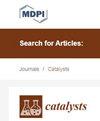A Cluster-Type Self-Healing Catalyst for Stable Saline–Alkali Water Splitting
IF 3.8
3区 化学
Q2 CHEMISTRY, PHYSICAL
引用次数: 0
Abstract
In electrocatalytic processes, traditional powder/film electrodes inevitably suffer from damage or deactivation, reducing their catalytic performance and stability. In contrast, self-healing electrocatalysts, through special structural design or composition methods, can automatically repair at the damaged sites, restoring their electrocatalytic activity. Here, guided by Pourbaix diagrams, foam metal was activated by a simple cyclic voltammetry method to synthesize metal clusters dispersion solution (MC/KOH). The metal clusters-modified hydroxylated Ni-Fe oxyhydroxide electrode (MC/NixFeyOOH) by a facile Ni-Fe metal–organic framework-reconstructed strategy, exhibiting superior performance toward the oxygen evolution reaction (OER) in the mixture of MC/KOH and saline–alkali water (MC/KOH+SAW). Specifically, using a nickel clusters-modified hydroxylated Ni-Fe oxyhydroxide electrode (NC/NixFeyOOH) for OER, the NC/NixFeyOOH catalyst has an ultra-low overpotential of 149 mV@10 mA cm−2, and durable stability of 100 h at 500 mA cm−2. By coupling this OER catalyst with an efficient hydrogen evolution reaction catalyst, high activity and durability in overall SAW splitting is exhibited. What is more, benefiting from the excellent fluidity, flexibility, and enhanced catalytic activity effect of the liquid NC, we demonstrate a self-healing electrocatalysis system for OER operated in the flowing NC/(KOH+SAW). This strategy provides innovative solutions for the fields of sustainable energy and environmental protection.用于稳定盐碱水分离的簇式自愈合催化剂
在电催化过程中,传统的粉末/薄膜电极不可避免地会受到损伤或失活,从而降低其催化性能和稳定性。相比之下,自修复电催化剂通过特殊的结构设计或组成方法,可以自动修复受损部位,恢复其电催化活性。在此,我们以 Pourbaix 图为指导,通过简单的循环伏安法活化泡沫金属,合成了金属簇分散液(MC/KOH)。在 MC/KOH 和盐碱水(MC/KOH+SAW)的混合液中,金属簇改性的羟基化 Ni-Fe 氧氢氧化物电极(MC/NixFeyOOH)在氧进化反应(OER)中表现出卓越的性能。具体来说,使用镍簇修饰的羟基化氢氧化镍铁电极(NC/NixFeyOOH)进行氧进化反应,NC/NixFeyOOH 催化剂具有 149 mV@10 mA cm-2 的超低过电位,并且在 500 mA cm-2 下具有 100 小时的持久稳定性。通过将这种 OER 催化剂与高效的氢进化反应催化剂耦合,可在整个声表面波裂解过程中表现出高活性和耐久性。此外,得益于液态 NC 卓越的流动性、灵活性和更强的催化活性效果,我们展示了一种在流动 NC/(KOH+SAW) 中运行的 OER 自修复电催化系统。这一策略为可持续能源和环境保护领域提供了创新解决方案。
本文章由计算机程序翻译,如有差异,请以英文原文为准。
求助全文
约1分钟内获得全文
求助全文
来源期刊

Catalysts
CHEMISTRY, PHYSICAL-
CiteScore
6.80
自引率
7.70%
发文量
1330
审稿时长
3 months
期刊介绍:
Catalysts (ISSN 2073-4344) is an international open access journal of catalysts and catalyzed reactions. Catalysts publishes reviews, regular research papers (articles) and short communications. Our aim is to encourage scientists to publish their experimental and theoretical results in as much detail as possible. Therefore, there is no restriction on the length of the papers. The full experimental details must be provided so that the results can be reproduced.
 求助内容:
求助内容: 应助结果提醒方式:
应助结果提醒方式:


